Buckinghamshire Railway Centre
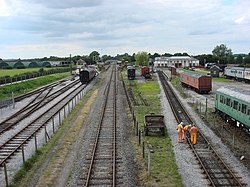 View along the main line towards Quainton Road, showing the two sides of the centre, taken from the footbridge. Main buildings, from left-right: Ministry of Food Buffer-Depot; Brill Tramway platform; Quainton Road; the former building of Oxford Rewley Road | |
 | |
| Established | 1969 |
|---|---|
| Coordinates | 51°51′54″N 0°55′44″W / 51.865°N 0.929°W |
| Type | Operational railway museum |
| Key holdings | Metropolitan Railway E Class No.1 GWR 4073 Class No.5080 Defiant GWR 6959 Class No.6989 Wightwick Hall South African Class 25NC 4-8-4 No.3405 |
| Owner | Quainton Railway Society (Some land leased from Network Rail) |
| Public transit access | Quainton Road or Aylesbury |
| Website | BucksRailCentre.org |
Buckinghamshire Railway Centre is a railway museum operated by the Quainton Railway Society Ltd. at Quainton Road railway station, about 5 miles (8.0 km) west of Aylesbury in Buckinghamshire, England. The site is divided into two halves which are joined by two foot-bridges, one of which provides wheelchair access. Each side has a demonstration line with various workshop buildings as well as museum buildings.
History

In 1962, the London Railway Preservation Society was formed. It bought a series of former London Underground vehicles and collectables, and holds the largest collection of London and North Western Railway memorabilia.[1] These were held at various sites around London, mainly two government depots at Luton and Bishop's Stortford,[2] making both access, restoration and preservation difficult.[1]
While other closed stations on the former MR lines north of Aylesbury were generally demolished or sold,[3] in 1969 the Quainton Railway Society was formed to operate a working museum at the station.[4] On 24 April 1971 the society absorbed the London Railway Preservation Society, taking custody of its collection of historic railway equipment.[5]
Restoration
The station was maintained in working order, used as a bookshop and ticket office.[6] The extensive sidings were still intact, and although disconnected from the mainline in 1967,[7] were used for locomotive restoration work.[4] The Society eventually restored the main station building to its 1900 appearance, renaming the site the Buckinghamshire Railway Centre.[8] A smaller building on the former Brill platform, once a shelter for passengers waiting for Brill and down trains, was used first as a store then as a shop for a number of years before its current use to house an exhibit on the history of the Brill Tramway. A former London Transport building from Wembley Park was dismantled and re-erected at Quainton Road to serve as a maintenance shed.[9]
Mainline services

Although the BRC's trains are run on the former station sidings, the station still has a working Network Rail line passing through it. This connects Aylesbury with the Bletchley to Oxford cross-country route at Claydon (LNE) Junction. Regular landfill freight trains traverse the line from waste transfer depots in Greater London to the former brick pits at Calvert.[10]
From 1984 until 1990, the station briefly came back into passenger use, when special Christmas shopping services between Aylesbury and Bletchley were operated by British Rail Network SouthEast on Saturdays only, and stopped at Quainton Road.[11] From August Bank Holiday 1971 until the 1987 season, and again from August Bank Holiday 2001 the station has had special passenger trains from Aylesbury in connection with events at the Centre - these shuttles now run regularly each Spring and August Bank Holiday weekend.
Present
With an extensively redeveloped site on both sides of the working mainline, BRC houses around 170 items of locomotives and rolling stock, in buildings dating from 1874 to the 1960s. The adjacent World War II warehouses of the Ministry of Food Buffer Depot in the former downside yard have been taken over to display many items awaiting restoration, whilst the Society have added a members' reference library.
Rewley Road

Rewley Road, the Oxford terminus of Harry Verney's Buckinghamshire Railway and of the Oxford to Cambridge Line, closed to passengers on 1 October 1951 with trains diverted to the former GWR Oxford General, the current Oxford station. In co-operation with the Science Museum, Rewley Road was dismantled in 1999. The main station building and part of the platform canopy were then moved to BRC and re-erected in 2002 at the north-west corner of the site, now providing improved visitor facilities and the main offices of the QRS.[12]
Media
As one of the best-preserved period railway stations in England, Quainton Road is regularly used as a filming location for period drama, and programmes such as The Jewel in the Crown, the Doctor Who serial Black Orchid and Midsomer Murders have been filmed there.[7]
Future developments
As of 2010[update] the Buckinghamshire Railway Centre is negotiating for a reconnection of the link between its sidings and the main line to allow their locomotives to run to Aylesbury when the line is not in use by freight trains, and to rebuild part of the Brill Tramway between Quainton Road and Waddesdon Road.[13][14]
High Speed 2's planned route passes immediately to the west of the site, not impacting the centre directly, although it will preclude any restoration of the Brill Tramway.[15]
Collection
The collection includes locomotives, carriages, and assorted rolling stock, plus a large amount of memorabilia and documents.[16]
Locomotives
| Class | Number ( and name) | Chassis | Status | Notes | Image |
|---|---|---|---|---|---|
| Metropolitan Railway E Class |
No.1 (London Transport L44) | 0-4-4T | Operational | Built 1898. Operational and a regular on passenger trains. On loan to the Epping Ongar Railway. Boiler ticket expires in 2022. | 
|
| LSWR 0298 Class |
314 (British Railways 30585) |
2-4-0WT | Static Display | Built 1874. Boiler ticket expired in 2016. | 
|
| Peckett and Sons | No.1159 Annie |
0-4-0ST | Under Overhaul | Built 1908. Arrived in April 2018 from the Embsay and Bolton Abbey Steam Railway. Part way through a major overhaul. | |
| Peckett and Sons | No.2105 Rokeby |
0-4-0ST | Static Display | Built 1951. Mainly used on goods/vintage trains. | 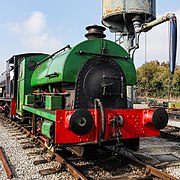
|
| North British Locomotive Company | Coventry No.1 |
0-6-0T | Static Display | Built 1939. Previously acted as Thomas the Tank Engine on "Thomas" days. On Static display after her Boiler certificate expired. | 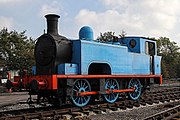
|
| Hudswell Clarke | No.1742 Millom |
0-4-0ST | Operational | Built 1946. Used on goods and vintage trains. Boiler ticket expires in 2027. | |
| GWR 9400 Class | 9466 | 0-6-0PT | Operational | Built 1952, mainline certified. Boiler ticket expires in 2026. | 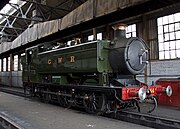
|
| Aveling and Porter | No.3587 Sydenham |
0-4-0WT | Under Overhaul | Built 1895 | 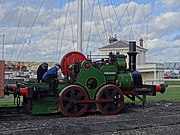
|
| GWR 6959 Class | 6989 Wightwick Hall |
4-6-0 | Under Overhaul | Built 1948. To be in service within the second half of 2018. | 
|
| GWR 7200 Class | 7200 | 2-8-2T | Under Restoration | Built in 1934 | |
| Hunslet Austerity 0-6-0ST | No.3890 NCB 66 |
0-6-0ST | Operational | Last Hunslet Austerity built. in 1964. Boiler ticket expires in 2024 | 
|
| Peckett and Sons | No.1900 | 0-4-0ST | Under Overhaul | Built 1936. Britain's smallest standard-gauge steam locomotive. | |
| Andrew Barclay | No.699 Swanscombe |
0-4-0ST | Operational | Built 1891. Boiler ticket expires in 2023. The oldest surviving Barclay. Repainted in July 2013 into pseudo-Metropolitan Railway livery as Brill No. 1. | 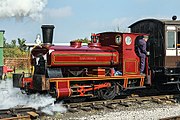
|
| Bagnall | No.2469 Scott |
0-4-0ST | Operational | Built 1932. Boiler ticket expires in 2024. mainly used on goods trains | 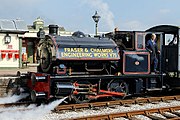
|
| Andrew Barclay | No.1477 | 0-4-0F | Static Display | Built 1916. Fireless | |
| Andrew Barclay | No.2243 | 0-4-0F | Static Display | Built 1948. Fireless | |
| Aveling and Porter | No.807 Brill |
0-4-0T | Static Display | Built 1872. Brill Tramway No.1 | 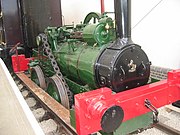
|
| GWR 5700 Class | 7715 (London Transport L99) |
0-6-0PT | Static Display | Built 1930. Bought by London Transport in 1963, their L.99 until 1969. Out of service from December 2011 with a cracked boiler foundation ring | 
|
| Hawthorn Leslie | No.3717 Swanscombe No.3 |
0-4-0ST | Static Display | Built 1928 | |
| Hawthorn Leslie | No.3718 Swanscombe No.4 |
0-4-0ST | Operational | Built 1928. Arrived in 2018 near the end of a major overhaul. She entered service in August 2018. Boiler ticket expires 2028 | |
| Hudswell Clarke | No.1334 Sir Thomas |
0-6-0T | Static Display | Built 1918 | |
| Hunslet | No.3782 Arthur |
0-6-0ST | Under Overhaul | Built 1953 | |
| LNWR | 3020 Cornwall |
2-2-2 | Static Display | Built 1847. On display inside the Rewley Road visitor centre. On loan from the National Railway Museum | 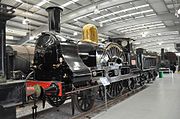
|
| South African Class 25NC | 3405 | 4-8-4 | Static Display | Built 1953. 3 ft 6 in (1,067 mm) gauge | 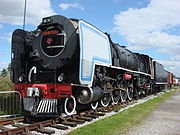
|
| Sentinel Waggon Works | No.6515 Isebrook |
4wd | Under Overhaul | Built 1945 | 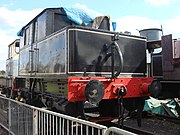
|
| Sentinel Waggon Works | No.9366 Cynthia | 4wd | Operational | Built 1945. Returned to steam in late 2017 after a major overhaul. Boiler ticket expires in 2027 | 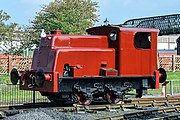
|
| Yorkshire Engine Company | No.2498 Chislet |
0-6-0ST | Static Display | Built 1951 | |
| British Rail Class 04 | D2298 | 0-6-0DM | Under Restoration | Built 1960 under restoration after suffering an engine failure at The East Lancashire railway. | 
|
| John Fowler | No.20067 Osram |
0-4-0DM | Static Display | 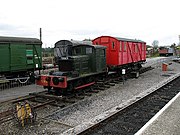
| |
| F.C. Hibberd "Planet" | No.3765 | 0-4-0DM | Operational | ||
| F.C. Hibberd | No.2102 | 0-4-0DM | Static Display | 
| |
| F.C. Hibberd | No.3271 Walrus |
0-4-0DM | Static Display | 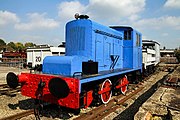
| |
| Hunslet | K4428 Redland |
0-4-0DM | Static Display | ||
| Hunslet | No.2067 | 0-4-0DM | Operational | ||
| Ruston & Hornsby | No.425477 | 0-4-0DM | Operational | ||
| Ruston & Hornsby | No.463153 Hilsea |
0-4-0DM | Under Overhaul | Ex-British Gas | 
|
Diesel multiple units
- BR Class 115 unit 51886+59761+51889 "Aylesbury College Silver Jubilee 1987"[citation needed]
Electric multiple units

- Post Office Railway (London) 1930 Stock No. 803 [17]
- London Underground CO/CP Stock unit 53028+013063+54233 [3][4][5]
- New York Subway Car No. 1144, an R6, converted into a cafeteria for the museum.[18]
Carriages and vans
- BR Mk 1 TPO sorting van no. 80394
- London Transport brake vans nos. B557 and FB578
References
- ^ a b Simpson 1985, p. 110.
- ^ Oppitz 2000, p. 70.
- ^ Simpson 2005, p. 35.
- ^ a b Mitchell & Smith 2006, §16.
- ^ Oppitz 2000, pp. 70–71.
- ^ Jones 1974, p. 58.
- ^ a b Perfitt, Geoff (7 April 1994). "Those silver days of steam at Quainton". Bucks Herald. Aylesbury. p. 12.
- ^ Mitchell & Smith 2006, §18.
- ^ Oppitz 2000, p. 71.
- ^ Oppitz 2000, p. 66.
- ^ Quick (2009): "Railway Passenger Stations in Great Britain" and Chiltern Lines News
- ^ QRS publication "Quainton News", Annual Report of the Quainton Railway Society (various years)
- ^ Oppitz 2000, p. 72.
- ^ Jones 2010, p. 45.
- ^ London-West Midlands Environmental Statement Volume 5 Technical Appendices CFA12 Waddesdon and Quainton Impact assessment tables (CH-003-012) Cultural heritage (PDF). e Department for Transport (DfT). November 2013. p. 5. Retrieved 2 December 2017.
- ^ Quainton Railway Society. "Quainton Virtual Stockbook Home". Retrieved 8 June 2008.
- ^ [1]
- ^ [2]

